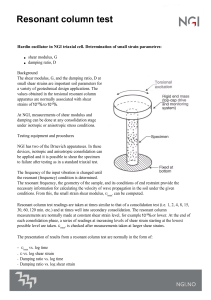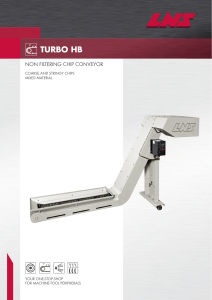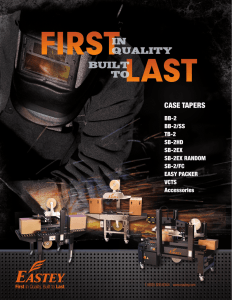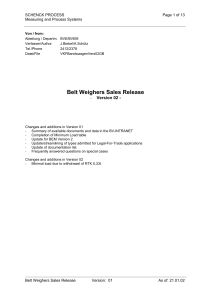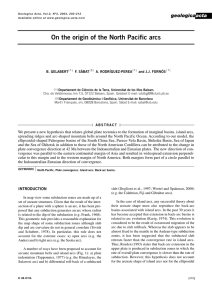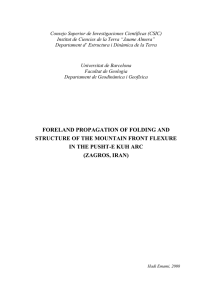Contrasting structural styles in SW Dominican Republic as an
Anuncio
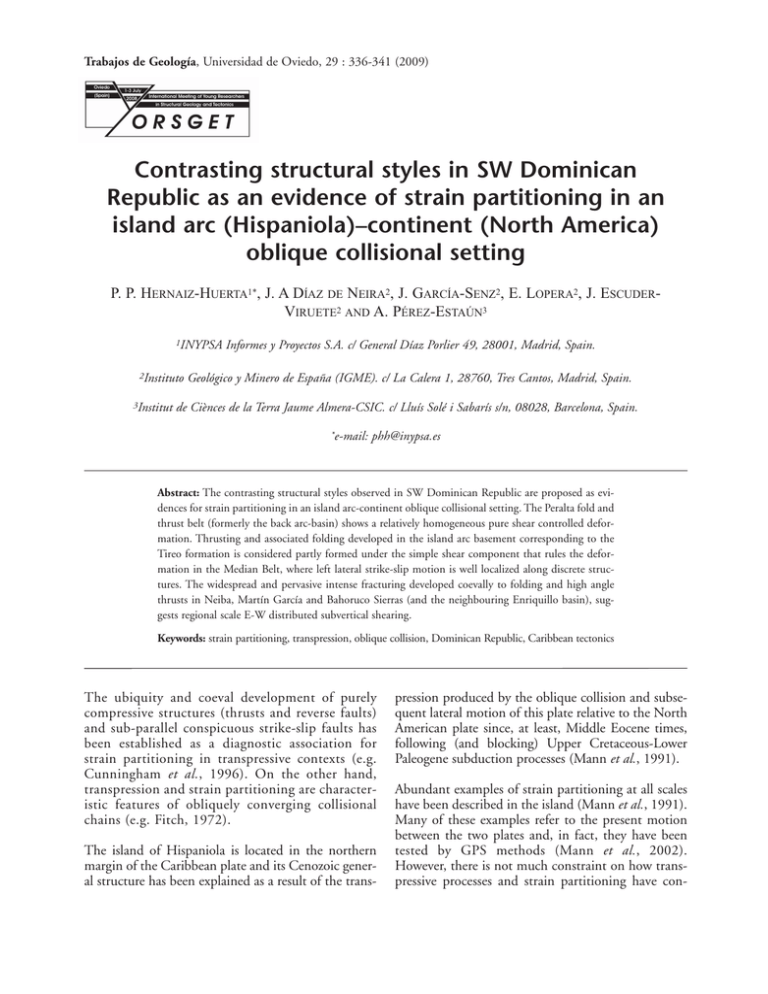
Trabajos de Geología, Universidad de Oviedo, 29 : 336-341 (2009) Contrasting structural styles in SW Dominican Republic as an evidence of strain partitioning in an island arc (Hispaniola)–continent (North America) oblique collisional setting P. P. HERNAIZ-HUERTA1*, J. A DÍAZ DE NEIRA2, J. GARCÍA-SENZ2, E. LOPERA2, J. ESCUDERVIRUETE2 AND A. PÉREZ-ESTAÚN3 1INYPSA 2Instituto 3Institut Informes y Proyectos S.A. c/ General Díaz Porlier 49, 28001, Madrid, Spain. Geológico y Minero de España (IGME). c/ La Calera 1, 28760, Tres Cantos, Madrid, Spain. de Ciènces de la Terra Jaume Almera-CSIC. c/ Lluís Solé i Sabarís s/n, 08028, Barcelona, Spain. *e-mail: phh@inypsa.es Abstract: The contrasting structural styles observed in SW Dominican Republic are proposed as evidences for strain partitioning in an island arc-continent oblique collisional setting. The Peralta fold and thrust belt (formerly the back arc-basin) shows a relatively homogeneous pure shear controlled deformation. Thrusting and associated folding developed in the island arc basement corresponding to the Tireo formation is considered partly formed under the simple shear component that rules the deformation in the Median Belt, where left lateral strike-slip motion is well localized along discrete structures. The widespread and pervasive intense fracturing developed coevally to folding and high angle thrusts in Neiba, Martín García and Bahoruco Sierras (and the neighbouring Enriquillo basin), suggests regional scale E-W distributed subvertical shearing. Keywords: strain partitioning, transpression, oblique collision, Dominican Republic, Caribbean tectonics The ubiquity and coeval development of purely compressive structures (thrusts and reverse faults) and sub-parallel conspicuous strike-slip faults has been established as a diagnostic association for strain partitioning in transpressive contexts (e.g. Cunningham et al., 1996). On the other hand, transpression and strain partitioning are characteristic features of obliquely converging collisional chains (e.g. Fitch, 1972). The island of Hispaniola is located in the northern margin of the Caribbean plate and its Cenozoic general structure has been explained as a result of the trans- pression produced by the oblique collision and subsequent lateral motion of this plate relative to the North American plate since, at least, Middle Eocene times, following (and blocking) Upper Cretaceous-Lower Paleogene subduction processes (Mann et al., 1991). Abundant examples of strain partitioning at all scales have been described in the island (Mann et al., 1991). Many of these examples refer to the present motion between the two plates and, in fact, they have been tested by GPS methods (Mann et al., 2002). However, there is not much constraint on how transpressive processes and strain partitioning have con- STRAIN IN AN ISLAND ARC (HISPANIOLA)–CONTINENT (NORTH AMERICA) OBLIQUE COLLISIONAL SETTING trolled the Cenozoic geologic and structural evolution of the island. The contrasting structural styles that recent geological mapping has revealed to exist among neighbouring geological domains in SW Dominican Republic, are proposed in this contribution as an evidence for strain partitioning in response to continuous transpression transmitted from the northern margin of the Caribbean plate southwards inland, since (at least) Lower-Middle Eocene times to present times. Geological setting and basic stratigraphy In SW Dominican Republic three main geological domains can be distinguished, from NE to SW, the 337 island arc basement, the Peralta Belt (these two belonging to the Central Cordillera) and the herein so-called Southern Calcareous Sierras (Neiba, Martín García and Bahoruco Sierras). Additionally, in between these prominent relieves (above 2000 m), there are two Neogene basins: the San Juan-Azua and Enriquillo basins (Fig. 1). In the easternmost part of the basement named as the Median Belt (Bowin, 1966), Lower Cretaceous highly deformed and metamorphosed units (Duarte complex, Río Verde complex and Maimon schists) related to the primitive stages of the island arc development, and also a couple of non-metamorphic and non-internally deformed Upper Cretaceous units (Siete Cabezas and South Peralvillo Fms), crop out along Figure 1. Simplified 3D block of the study area with location of A-A´, B-B´ and C-C´ cross sections depicted in figure 2. Inset box shows situation of study area in SW Dominican Republic. Abbreviations: NS: Neiba Sierra; BS: Bahoruco Sierra; MGS: Martín García Sierra; EB: Enriquillo Basin; SJB: San Juan Basin; AB: Azua Basin; CB: Cibao Basin; PB: Peralta Belt; MB: Median Belt; CBS: Caribbean Slab; NAS: North American Slab; O-cr: Oceanic-type crust; IA-cr: Island arc-type crust (adapted from Hernaiz Huerta, 2006). 338 P. P. HERNAIZ-HUERTA, J. A DÍAZ DE NEIRA, J. GARCÍA-SENZ, E. LOPERA, J. ESCUDER-VIRUETE AND A. PÉREZ-ESTAÚN fault bounded, several km wide NW-SE-striking bands, adjacent to a central ridge of peridotites. The group of faults bounding the peridotitic ridge itself and the closer non metamorphic units is known as La Española Fault Zone (LEFZ). The western part of the basement is occupied by the Tireo Fm, a 4.5 km thick calc-alkaline volcano-sedimentary unit of Upper Cretaceous age that is considered the main magmatic product of the island arc related to the subduction of the North American plate underneath the Caribbean plate (Lewis and Jiménez, 1991). The basement is intruded by plutonic rocks, mostly gabbro-norites and tonalities, linked to this magmatic activity. The Peralta Belt, located to the SW of the basement, is identified with the back arc basin. In the study area only the lower Peralta and Rio Ocoa stratigraphic groups are represented (Heubeck, 1988). The Peralta Group (of Paleocene-Upper Eocene age) is a 4000-5000 m thick succession of siliciclastic turbiditic formations (lower Ventura Fm and upper El Numero Fm) with an intermediate interval of platform limestones (Jura Fm). Ocoa is the only formation of Rio Ocoa Group represented in the study area. It is an 8000 m thick turbiditic, mostly chaotic unit, which was deposited in a short time span during Upper Eocene along a NW-SEstriking trough fed by an active eastern margin (Frontal Basement Thrust). In Neiba, Martín García and Bahoruco Sierras, there is a clear predominance of calcareous materials belonging to Neiba and Sombrerito Fms of EoceneLower Miocene and Miocene ages, respectively (Mann et al., 1991). In the Haitian prolongation of Bahoruco Sierra it is well known that Neiba or equivalent formations rest upon Upper Cretaceous E-morb basalts and associated sediments belonging to the (uplifted) Caribbean Oceanic Plateau (Maurrasse et al., 1979); similar relationships have been inferred in Neiba Sierra (Hernaiz Huerta et al., 2007). The more than 4000 m of approximately coeval infill of San Juan-Azua and Enriquillo basins record a shallowing upwards marine-continental mega-sequence that starts with Upper MioceneLower Pliocene deep water siliciclastic turbidites and ends up with Plio-Pleistocene alluvial fan conglomerates (Mann et al., 1991). An evaporitic episode of Pliocene age is exclusive of the Enriquillo basin. Structural styles Structure of the basement The Cenozoic structure of the basement is depicted in the composite cross section A-A´ of figure 2. In the Median Belt the most relevant structure is La Española Fault Zone (LEFZ) which controls the vertical faulted contacts between the ridge of peridotites (here divided in two branches) and their adjacent units. The cartographic fabric is coherent with a localized left lateral (and reverse) subvertical shearing along NW-SE main faults, produced under an approximate E-W shortening direction. In the NE limit of the Median Belt, the Hatillo thrust is a 40-50º W-dipping structure that brings the Maimon schists against different units of the Eastern Cordillera. On the opposite side of the Median Belt two main structures have been recently mapped, the Río Yuna and La Yautia thrusts (Fig. 2, section A-A´). The first one is a N-S-striking and 40-60º E-dipping thrust, that superimposes the Duarte complex over the Tireo Fm. The second one, with approximate the same strike and dip, is located several kilometres east of the former one and superimposes the gabbros and gabbro-norites of La Yautia batholith over a small stock of non-foliated tonalites. In both cases these thrusts characteristically develop, mainly in the hanging wall, thick ductile or brittle-ductile shear zones with an associated retrograde metamorphism. Kinematic indicators show a west tectonic transport of the thrusts. The structure of Tireo Fm is defined by a frontal thrust (Frontal Basement Thrust) and several internal imbricates, all together showing a peculiar bending in plant view of about 90º. Folds are considered to be fault-bend folds. Deformation observed along thrust planes is cataclastic with an associated very low grade of metamorphism. The bended imbricate general structure of Tireo Fm has been tentatively interpreted to have formed as internal thrusting progressed southwestwards above a pronounced, similarly oriented, lateral ramp. Structure of the Peralta Belt The Peralta Belt has a fold and thrust structure (Fig. 2, section B-B´). From SW to NE it can be distinguished a thrust dominated frontal zone; a fold dominated intermediate zone, and a monocline back zone. The monocline zone is considered to be controlled by the position of a ramp in the footwall. STRAIN IN AN ISLAND ARC (HISPANIOLA)–CONTINENT (NORTH AMERICA) OBLIQUE COLLISIONAL SETTING 339 Figure 2. Simplified geological sections across the island arc basement (A-A´), Peralta Belt (B-B´), and Southern Calcareous Sierras and Enriquillo Basin (C-C´). See location of cross sections in figure 1. Abbreviations: Pt: Peridotite; Dt: Duarte Complex; Rv: Rio Verde Complex; Ms: Maimon Schists; Tr: Tireo Fm; Sc: Siete Cabezas Fm; Pv: South Peralvillo Fm; Gr: Gabbro-norite; Tn: nonfoliated tonalites; Tnf: foliated tonalites; Dj: Don Juan Fm; Ve: Ventura Fm; Ju: Jura Fm; En: El Número Fm; Oc: Ocoa Fm; So: Sombrerito Fm; Nb: Neiba Fm; Nbi: lower Neiba Fm; Nbs: upper Neiba Fm; Cvs: El Aguacate Volcanosedimentary Complex; Tch: Trinchera Fm; An: Angostura Fm; Ab: Arroyo Blanco-Las Salinas Fm; Ji: Jimaní Fm. Notice that representation scales are different for each cross section, but vertical and horizontal scales are the same within one section (adapted from Hernaiz Huerta, 2006). The construction of the cross section above this ramp needs to incorporate the Tireo Fm in the basal thrust to solve a “space problem”. The traces of folds are typically rectilinear in this belt and en echelon patterns (typical of wrench fault systems) are absent or uncommon; thus, most of them are interpreted to be fault-propagation folds. In the frontal thrust zone, aligned hinges suggest the location of a flat in the footwall at about 500 to 1000 m below sea level. A NE-SW tectonic transport direction is deduced from the orientation of fold axes, cut off and branch lines, tear faults and lateral ramps. The internal geometry of the belt fits well with a forward propagation movement of the thrusts. Restored cross-sections allow estimating about 12 km (40%) of internal shortening plus 10 to 15 km of maximum translation over the Azua basin. Structure of Southern Calcareous Sierras (Neiba, Martín García and northern margin of Bahoruco Sierra) and Enriquillo Basin The sierras form large anticlinorial domes overthrusting the neighbouring San Juan and Enriquillo basins (Fig. 2, section B-B´). Folding is broad, with axis showing changing directions along strike and an en echelon pattern interrupted by sin-genetic strike-slip faults. Anticlines show a conical geometry, i.e. they are characteristically double plunging and quickly merge and disappear along strike. Synclines are usually narrow and overthrusted by neighbour anticlines. Reverse fault planes are quite steep or subvertical, as well as fold axis; these may easily change their facing direction along strike. The transition towards the basins is generally controlled by successive thrusts, and so, unique frontal thrusts are uncommon. 340 P. P. HERNAIZ-HUERTA, J. A DÍAZ DE NEIRA, J. GARCÍA-SENZ, E. LOPERA, J. ESCUDER-VIRUETE AND A. PÉREZ-ESTAÚN Discusion and conclusions The overall structure in the study area can be explained as a result of inhomogeneous transpressive deformation that is partitioned in blocks with differential predominance of the simple shear component with respect to the pure shear component. Consequently, each block has a particular structural style. From NW to SE the following main blocks can be distinguished (Hernaiz Huerta, 2006) (Fig. 3): respect to the dominant pure shear component oriented perpendicular to the structural fabric (and approximately coincident with the tectonic transport direction). However it is possible that some imbricates of the basement, specially the oldest and innermost ones, might be alternative or additionally explained as related to the movement along the LEFZ, that is, produced in the western part of the large flower structure that affects the Median Belt. The La Española Fault Zone (LEFZ) block The Neiba, Martin García, northern margin of Bahoruco Sierra and Enriquillo basin (N-MG-B-E) block It is a subvertical crustal scale NW-SE-striking shear zone dominated by the simple shear component, It is a regional scale E-W subvertical shear zone widely distributed in strike-slip faults, thrusts, reverse Figure 3. Strain partitioning in blocks with particular structural styles. The estimated relationship between shear and normal component is qualitative. See text for explanation. Legend for surface geology as in figure 1 (adapted from Hernaiz Huerta, 2006). characterized by left lateral mayor strike-slip faults and associated R type riedels. This block works coeval and jointly with the Eastern Cordillera (EC) block, located east of the study area, in which transpressive deformation is more distributed in NW-SE subvertical strike-slip faults, parallel to the LEFZ, and an associated folding. Kinematic analysis of cartographic structures in these blocks, suggest an E-W shortening direction. The island arc basement and back arc basin (IAB-BA) block In this block the structure is defined by internal imbricates (Tireo Fm and western Median Belt) and rectilinear folds related to thrusting (Peralta Belt). Here, simple shear component seems to be minimized with faults and an associated folding. In this case, transpressive deformation is a combination of pure shear and simple shear, probably with a certain predominance of the latest. Kinematic analysis of cartographic structures suggests a NE-SW shortening direction that is similar to the one deduced in the former block. According to the associated syntectonic deposits, the onset of the deformation is diachronic for the different blocks. It starts in the Lower Paleogene in LEFZ and Eastern Cordillera blocks and propagates south or southwestwards, progressively incorporating southernmost regions: the island arc basement from Eocene, the Peralta Belt from Oligocene-Lower Miocene, and the southern calcareous sierras and Enriquillo basin, from Lower-Middle Pliocene (Fig. 1). STRAIN IN AN ISLAND ARC (HISPANIOLA)–CONTINENT (NORTH AMERICA) OBLIQUE COLLISIONAL SETTING 341 In this context, the impingement of the Beata ridge north of Ocoa Bay has a localized effect superimposed to the regional transpression deformation and produces: 1) the formation of the conspicuous arc of sierras de La Vigia, Loma Vieja and Los Cacheos in eastern Azua Basin, 2) the bending of the Peralta Belt coevally to its development and translation over the Azua basin, and 3) the complete closure of the Azua basin as a consequence of the progression of the former processes. On top of this, it is also suggested that this structure may have acted as a transcurrent fault zone controlling the western interruption of Los Muertos trench and, even, the eastern termination of Enriquillo fault. References HEUBECK, C. (1988): Geology of the southeastern termination of the Cordillera Central, Dominican Republic. MSc Thesis, University of Texas, Austin, 333 pp. BOWIN, C. (1966): Geology of Central Dominican Republic. A case history of part of an island arc. In: H. HESS (ed): Caribbean geological investigations. Geol. Soc. Am. Mem., 98: 11-84 CUNNINGHAM, D., WINDLEY, B. F., DORNAMJAA, D., BADAMGAROV, G. and SAANAR, M. (1996): A structural transect across the Mongolian Western Altai: active transpressional mountain building in central Asia. Tectonics, 15: 142-156 FITCH, T. J. (1972): Plate convergence, transcurrent faults and internal deformation adjacent to South-East Asia and the western Pacific. J. Geophys. Res., 77: 4432-4459. HERNAIZ HUERTA, P. P. (2006): La estructura del sector meridional de la República Dominicana. Una aproximación a su evolución geodinámica durante el Cenozoico. PhD Thesis, Universidad Complutense de Madrid, 287 pp. HERNAIZ HUERTA, P. P., DÍAZ DE NEIRA, J. A., GARCÍA SENZ, J., DESCHAMPS, I., LOPERA, E., ESCUDER VIRUETE, J., ARDÉVOL ORÓ, LL., GRANADOS, L., CALVO, J. P. and PÉREZ ESTAÚN, A. (2007): La estratigrafía de la sierra de Neiba (República Dominicana). In: A. PEREZ ESTAÚN, P. P. HERNAIZ HUERTA, E. LOPERA and M. JOUBERT (eds) Geología de la República Dominicana. Boletín Geológico y Minero, 118: 313-335. LEWIS, J. F. and JIMENEZ, J. G. (1991): Duarte Complex in the La Vega-Jarabacoa-Janico Area, Central Hispaniola: Geological and Geochemical Features of the Sea Floor During the Early Stages of Arc Evolution. In: P. MANN, G. DRAPER and J. F. LEWIS (eds): Geologic and tectonic development of the North America-Caribbean plate boundary in Hispaniola. Geol. Soc. Am. Spec. Pap., 262: 115142. MANN, P., DRAPER, G. and LEWIS, J. F. (1991): An overview of the geologic and tectonic development of Hispaniola. In: P. MANN, G. DRAPER and J. F. LEWIS (eds): Geologic and tectonic development of the North America-Caribbean plate boundary in Hispaniola. Geol. Soc. Am. Spec. Pap., 262: 1-28. MANN, P., CALAIS, E., RUEGG, J. C., DEMETS C., JANSMA, P. E. and MATTIOLI, G. S. (2002): Oblique collision in the northeastern Caribbean from GPS measurements and geological observations. Tectonics, 21: 1-26. MAURRASSE, F., HUSLER, G., GEORGES, G., SCHMITT, R. and DAMOND, P. (1979): Upraised Caribbean sea-floor below acoustic reflector B’’ and the Southern Peninsula of Haiti. Geol. Mijnbouw, 8: 71-83.
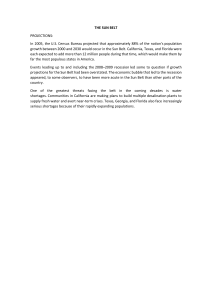

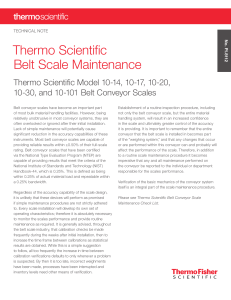
![Presentacion Chile - Canada [Modo de compatibilidad]](http://s2.studylib.es/store/data/006031439_1-d894d5d2d359230b5c2007cc916df922-300x300.png)
